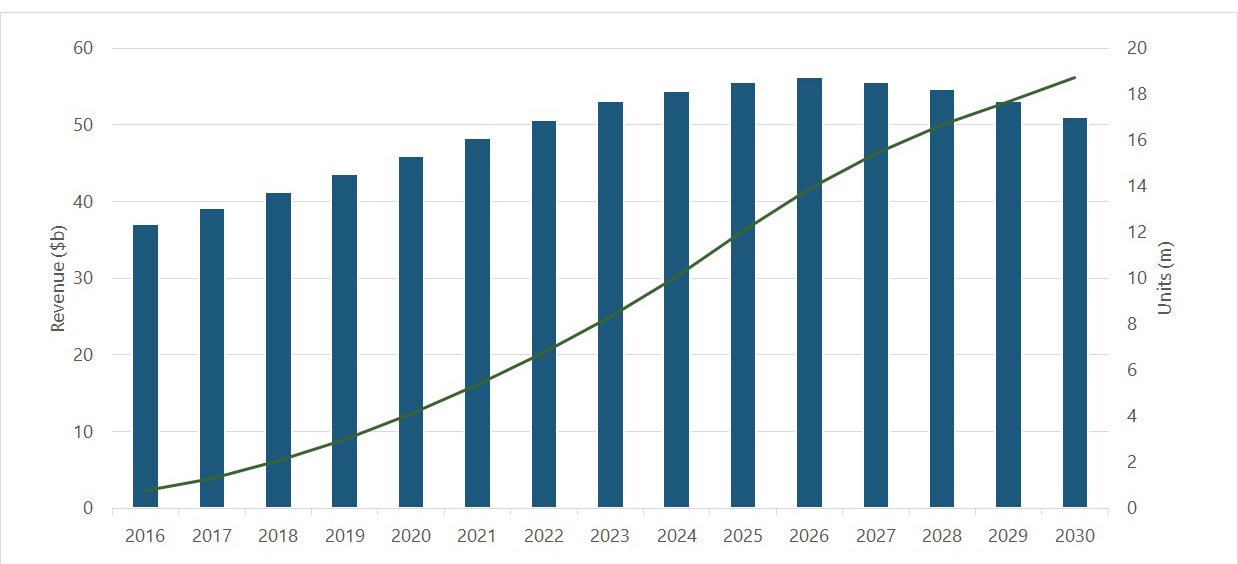Wide-scale adoption of electric vehicles (EVs) will impact the automotive industry on all fronts, including the supply chain structure, labor workforces, established business models, and the competitive landscape. A key difference in the manufacturing of EV compared to internal combustion engine (ICE) vehicles is the number of components in the drivetrain. You will no longer need components such as the exhaust system, pistons, valves, crankshafts, engine blocks, exhaust headers, etc. This will result in less throughput of component stock in production facilities and a potential for market contraction for automotive machine tool manufacturing.
Component-specific machine tool manufacturers and suppliers are the most at risk with this shift since they are heavily dependent on the automotive combustion engine market. The reduction in throughput volume for these products will simply not be large enough to support the current number of players in the machine tool market.
In 2017, PTR estimates the machine tools market amounted to $98 billion, globally. Approximately 40% of this is attributed to the automotive manufacturing sector; just over $39 billion. By 2030 the automotive machine tool market will have only reached $51 billion, a compounded annual growth rate of 1.9% from 2017 levels. PTR predicts the automotive machine tools market will begin to contract by 2027, as shown in Figure-1 below.
Figure 1. Automotive Machine Tools Market & EV Shipment Forecasts, 2016 – 2030, Billion ($), Units (M)

The market for ICEs is not expected to vanish entirely. Other applications of ICE components will continue to be produced and keep a portion of the automotive machine tools market afloat, such as locomotives, heavy-commercial trucks, marine vessels, aircraft, generators, on- and off-highway equipment, farm equipment, and military vehicles. These sectors will not adopt battery-electric drivetrains as fast as passenger vehicles due to the power required for operation and/or the long-distance travel requirements. However, if the EV forecasts are accurate, then the current ICE market will shrink significantly and leave only a select number of machine tool manufacturers that will supply the components to these markets. And there are components that will need to be produced for EVs as well, such as battery casings, single-speed gearboxes, charging ports, etc. In addition, the manufacturing of batteries themselves could present an opportunity for machine builders and their component suppliers. However, the ‘net’ market volume will still be a deficit as the new applications for EV will not be enough to fill the gap left by reduced ICE demand.
Most of the components of the modern ICE are not found in pure electric vehicles. Exceptions to this are hybrids and in some electric drive systems, such as the Electric Drive Unit from Yasa Ltd. and GKN’s Integrated eDrive system, that are integrating a gearbox and/or mechanical power transfer units. The thought behind this is to achieve higher torque at lower speeds which could increase the efficiency of EV traction motors while operating below optimal speeds. In addition, several ‘traditional’ ICE Tier 1 suppliers are investing in electrification offerings in response to the increased demand for EVs, such as Continental, ZF, Schaeffler, and Magna.
Overall, the EV is a technology that is on track to impact the status quo of the automotive manufacturing sector and shake up the supply chain structure. Regardless of whether the EV sales grow by a 15% or 35% CAGR into 2030, the automotive manufacturing market will see an impact. ICE supply chain players are already forming partnerships and making acquisitions to advance their position in the electric vehicle market, specifically battery electric vehicles (BEVs) and plug-in hybrid electric vehicles (PHEVs), in preparation for a shift in consumer demand.
EV Impact Report
What will be the impact of increased Electric Vehicles(EV) on the surrounding ecosystem across EV value chain? How will the market develop for:
- Automotive Manufacturing
- EV Motors
- BEV Batteries
- Power Grid Infrastructure
- Car Charging Infrastructure
Download the abstract for detailed ToC.